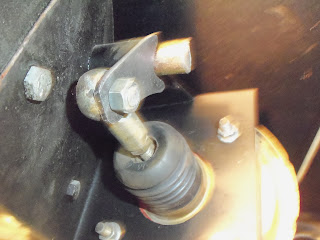One thing I always do when re-using bolts in a restoration is chase the threads. In putting the AC brackets back together for the 4th (but likely not the last) time, I cleaned up the bolts that will go into the block and pump, as well as the threaded ports in the block where it all mounts to.
I needed a specific shim to get the tensioner lined up just right, so I just made one out of some 3/8" stock by drilling a couple holes in the right spots, then cutting them into slots:
The finished product:
The tensioner pivots at the top bolt and slides along the slot in the bracket to adjust tension on the belt.
I had the power steering hose cut down and rebuilt at Greenline Automotive last week and just got to installing it. When I put it in the first time I realized it was going to interfere with the oil filter, making it real tough to change it during routine maintenance. So I flipped it over and mounted it with the hose facing forward. This gives us back the room to unscrew the oil filter - but now it rests against the upper control arm. Gonna have to think on that one for a spell - I wouldn't want the repeated contact from the suspension movement to cause an issue with it.....
Next up was the brake pedal assembly:
First up was to determine where everything was going to sit when the pedal was at rest and then fully depressed. We're using the original pedal shaft as it has the correct bits on the bottom end, so I had to find a nut that would fit the custom pedal that I could weld to the shaft:
Lots of checking pedal travel was key to the entire operation...
Under the vehicle, I mocked up the shaft, lever and pin, making sure the master cylinder rod would move all the way in and out and not bind up.
Once satisfied, I temporarily tacked the leg to the shaft.
With everything working, I took it all apart and fixed up the shaft so the pedal shaft would stay put when depressed. For this I put a flat spot where the set-screw would make contact. I also drilled a hole for a cotter pin to ensure this shaft couldn't go anywhere again!
The nearly finished piece:
Back under the car, I greased it, slid it through the mount and bolted it to the clevis. This bolt will get some Loctite before we call it done.
Looking at the other end you can see the set-screw on the bottom of the brake pedal. The first time I tightened the set-screw and depressed the pedal nothing happened. After some head-scratching I found that the set screw was binding in it's threads, so it would feel like it was tightening against the shaft, but really wasn't. That would be what happened to the first shaft! I removed it once again and ran a tap though the pedal, cleaning up some thread near the deep end and then the set screw went all the way to make contact with the shaft.
Then after welding that castle nut onto the shaft, I bolted the pedal on. Looks a little odd at this angle, but it seems good from inside. I also left the pedal high so as to err on the side of caution. Once we test the braking system and decide on a final spot, we can easily move it to suit the owner.
Looking under the dash, the EEC computer is mounted to the firewall and the E-brake lever (original) was mounted as well.

As the battery is being located in the trunk, I ran 4 gauge wire along the rail, separating it from the fuel line with rubber lined frame clamps.
...and here's the lug terminated at the solenoid:
MEANWHILE,, back at the farm....
After 4 hours on the Rod, I decided to keep the 240Z in play by doing a little bit on it as well. Under the battery tray is a rot-spot for all these vehicles. New metal on it's way!
As per my MO, I sprayed MetalReady on all the surface rust to stop it dead.
Looking ahead a bit, here's what lies in wait under a fiberglass quarter panel....
Here's where you can run that horror-movie music in your head: Dun-Dun-Dun-Dun.....
Cue screams of horror!!!!!
Yikes! Looks like a lot of work....but just think what it'll look like with NEW metal!
Don't forget to check out my website at www.E-tekRestorations.com !


























